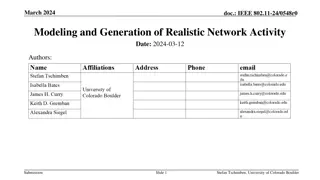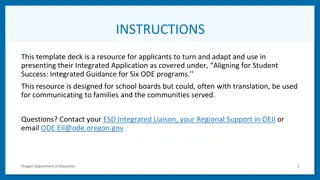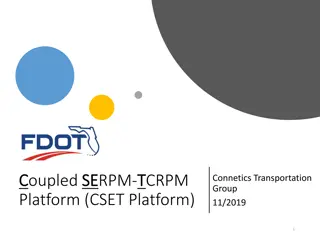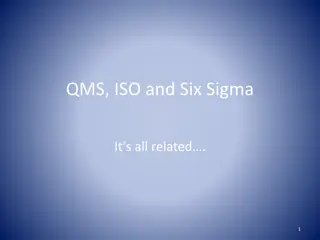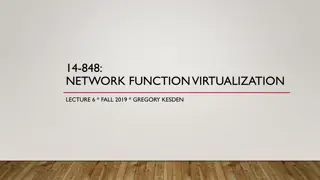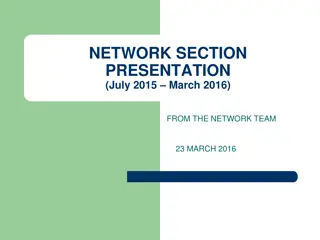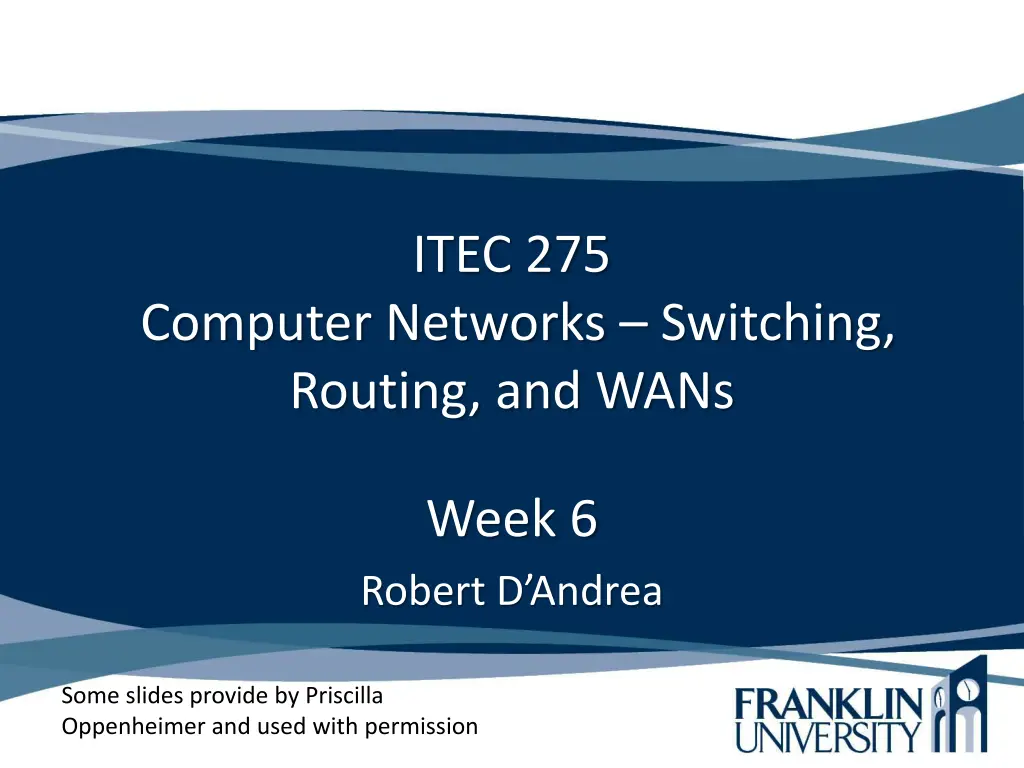
Understanding IP Addressing, Naming Guidelines, and Public IP Management
Learn about IP addressing strategies, guidelines for structured naming, advantages of structured models, public IP address management by IANA, roles of Regional Internet Registries, and criteria for choosing between static and dynamic addressing. Dive into the world of computer networks and enhance your knowledge for efficient network management.
Download Presentation

Please find below an Image/Link to download the presentation.
The content on the website is provided AS IS for your information and personal use only. It may not be sold, licensed, or shared on other websites without obtaining consent from the author. If you encounter any issues during the download, it is possible that the publisher has removed the file from their server.
You are allowed to download the files provided on this website for personal or commercial use, subject to the condition that they are used lawfully. All files are the property of their respective owners.
The content on the website is provided AS IS for your information and personal use only. It may not be sold, licensed, or shared on other websites without obtaining consent from the author.
E N D
Presentation Transcript
ITEC 275 Computer Networks Switching, Routing, and WANs Week 6 Robert D Andrea Some slides provide by Priscilla Oppenheimer and used with permission
Agenda Learning Activities IP Addressing Static and Dynamic Assignment IPv6 IPv4 to IPv6 Transition Methods
Guidelines for Addressing and Naming Use a structured model for addressing and naming. A topology may be useful for viewing the hierarchy in the network and recognize address boundaries. Assign addresses and names hierarchically Decide in advance if you will use Central or distributed authority for addressing and naming. Who is in charge of delegating addresses and naming conventions. Public or private addressing (IANA or RFC 1918) Static or dynamic addressing and naming (DHCP Dynamic Host Configuration Protocol)
Advantages of Structured Models for Addressing & Naming It makes it easier to Read network maps Operate network management software Recognize devices in protocol analyzer traces Meet goals for usability Design filters on firewalls and routers Implement route summarization The Structured Model for addressing provides IP addresses meaning, hierarchical, and planned.
Public IP Addresses Managed by the Internet Assigned Numbers Authority (IANA) Users are assigned IP addresses by Internet service providers (ISPs). ISPs obtain allocations of IP addresses from their appropriate Regional Internet Registry (RIR) Internet Assigned Numbers Authority (IANA). IANA allocates IP addresses to the Regional Internet Registries (RIRs)
Regional Internet Registries (RIR) American Registry for Internet Numbers (ARIN) serves North America and parts of the Caribbean. RIPE Network Coordination Centre (RIPE NCC) serves Europe, the Middle East, and Central Asia. Asia-Pacific Network Information Centre (APNIC) serves Asia and the Pacific region. Latin American and Caribbean Internet Addresses Registry (LACNIC) serves Latin America and parts of the Caribbean. African Network Information Centre (AfriNIC) serves Africa.
Criteria for Using Static Vs. Dynamic Addressing The number of end systems The likelihood of needing to renumber The need for high availability Security requirements The importance of tracking addresses Whether end systems need additional information (DHCP can provide more than just an address)
Criteria for Using Static Vs. Dynamic Addressing IPv6 Dynamic addressing supports both static and dynamic addressing -Dynamic addressing is referred to as auto-configuration and is made up of two components. Part 1: Stateful auto-configuration method, hosts retrieve addresses and other information from a server set up with a database.
Criteria for Using Static Vs. Dynamic Addressing Part 2: Stateless autoconfiguration method, a hosts generates it s own address using locally available information. This includes advertised information from routers. The process starts by generating a link-local address for an interface. This involves combining the well-known link- local prefix (FE80::/10) with a 64 bit interface identifier.
Criteria for Using Static Vs. Dynamic Addressing A link-local address is a network address that is valid only for communications within the network segment (link) or the broadcast domain that the host is connected to. Link-local addresses are usually not guaranteed to be unique beyond a single network segment. Routers therefore do not forward packets with link-local addresses.
Criteria for Using Static Vs. Dynamic Addressing For protocols that have only link-local addresses, such as Ethernet, hardware addresses that the manufacturer delivers in network circuits are unique, consisting of a vendor identification and a serial identifier. Link-local addresses for IPv4 are defined in the address block 169.254.0.0/16, in CIDR notation. In IPv6, they are assigned with the fe80::/10 prefix.
Criteria for Using Static Vs. Dynamic Addressing Link-local address is useful in the context of a single link or network. IPv6 link-local addresses can be configured automatically on an interface. Link-local addresses serve as a way for connecting devices on the same local network without the need for globally unique addresses. A router utilizing IPv6 must not forward packets that have either link-local source or destination address.
Criteria for Using Static Vs. Dynamic Addressing Link-local addresses are used in neighbor discovery and in stateless auto-configuration process. Media access control (MAC) addresses used in local broadcast networks, such as Ethernet which are link-local addresses. Such devices are configured with an address in hardware by the manufacturer.
The Two Parts of an IP Address 32 Bits Prefix Host Prefix Length
Prefix Length An IPv4 address is accompanied by an indication of the prefix length Subnet mask /Length Examples 192.168.55.1 255.255.255.0 192.168.55.1/24
Subnet Mask 32 bits long Specifies which part of an IP address is the network/subnet field and which part is the host field The network/subnet portion of the mask is all 1s in binary. The host portion of the mask is all 0s in binary. Convert the binary expression back to dotted-decimal notation for entering into configurations. Alternative Use slash notation (for example /24) Specifies the number of 1s
Shorthand Subnet Mask Class C Subnet Binary 10000000 11000000 11100000 11110000 11111000 11111100 11111110 The shorthand notations represent how many bits are used in the subnet mask. The minimum subnet mask for a Class C address must be 255.255.255.0, which is 24 bits (8 bits in each octet), or /24. Decimal Shorthand 128 192 224 240 248 252 254 /25 /26 /27 /28 /29 /30 /31 (not valid)
Shorthand Subnet Mask 2^0 = 1 2^1 = 2 2^2 = 4 2^3 = 8 2^4 = 16 2^5 = 32 2^6 = 64 2^7 = 128 2^8 = 256
Subnet Mask Example 11111111 11111111 11111111 00000000 What is this in slash notation? What is this in dotted-decimal notation?
Subnet Mask Example 11111111 11111111 11111111 00000000 What is this in slash notation? /24 What is this in dotted-decimal notation? 255.255.255.0
Another Subnet Mask Example 11111111 11111111 11110000 00000000 What is this in slash notation? What is this in dotted-decimal notation?
Another Subnet Mask Example 11111111 11111111 11110000 00000000 What is this in slash notation? /20 What is this in dotted-decimal notation? 255.255.240.0
One More Subnet Mask Example 11111111 11111111 11111000 00000000 What is this in slash notation? What is this in dotted-decimal notation?
One More Subnet Mask Example 11111111 11111111 11111000 00000000 What is this in slash notation? 21 What is this in dotted-decimal notation? 255.255.248.0
Private and Public Addresses Figure 6-1
Network Address Translation (NAT) Static One private address to one public address Used for servers that must be visible to the public network Dynamic Many unregistered addresses to one registered address from a pool of addresses (similar to PBX) Used for workstations that only connect to the public network when required Combination Used by most organizations
Network Address Translation (NAT) Problem with Private Addressing Outsourcing network management responsibilities to an outside vendor. With private addressing, the internal networks are not advertised to the outside. NAT problems would occur handling network management protocols like Simple Network Management Protocol (SNMP).
Network Address Translation (NAT) Simple Network Management Protocol (SNMP). Enterprise networks are heterogeneous. In addition to multi-tiered applications, a critical part of the infrastructure consists of network devices and other applications that are vendor specific. However, these devices normally have a Simple Network Management Protocol (SNMP) agent (interface) and this facilitates SNMP monitoring.
Network Address Translation (NAT) What is SNMP? SNMP stands for Simple Network Management Protocol and is an industry standard for the communication among devices in your IT infrastructure. It is used for collecting information from and sending configuration to devices such as servers, printers, hubs, switches, and routers in your network. SNMP lets you keep an eye on network and bandwidth usage and track important issues such as uptime and traffic levels.
Network Address Translation (NAT) Network Address Translation (NAT) is a methodology of modifying network address information in Internet Protocol (IP) datagram packet headers while they are in transit across a traffic routing device for the purpose of remapping one IP address space into another.
Address use in the Enterprise Figure 6-3
Designing Networks with Subnets Determining subnet size Computing subnet mask Computing IP addresses
Determinations How many locations? How many segments are required? How many devices? How large must each segment be? What are the IP addressing requirements for each location? Is public access required? What subnet size is appropriate? Determined by first and second questions
Addresses to Avoid When Subnetting A node address of all ones (broadcast) A node address of all zeroes (network) A subnet address of all ones (all subnets) A subnet address of all zeroes (confusing) Cisco IOS configuration permits a subnet address of all zeroes with the ip subnet-zero command.
IP Subnet-Zero Under old IP sub-netting rules, the all 0 s subnet was reserved for the network, and the all 1 s subnet was reserved for the broadcast. Overtime, engineers found that the all 0 s subnet wasn t really used and, if it could be handed out as a useable network, many IP addresses could be changed.
IP Address Classes Classes are now considered obsolete But you have to learn them because Everyone in the industry still talks about them! You may run into a device whose configuration is affected by the classful system
IP Address Classes Traditional routing, is known as classful routing. No information is transmitted about the prefix length. The hosts and router examine the first three bits of the IP address to determine its class. Class A 00000000 = 0 01111111 = 127
IP Address Classes Class B 10000000 = 128 10111111 = 191 Class C 11000000 = 192 11011111 = 223
IP Address Classes Classless Inter Domain Routing (CIDR) notation identifies the prefix length with a length field, followed by a slash. Example: 10.1.0.1/16 The prefix length is 16 bits long. The subnet mask is 255.255.0.0.
Classful IP Addressing Class First Few Bits First Byte Prefix Length Intent A B C D E 0 10 110 1110 1111 1-126* 128-191 192-223 224-239 240-255 8 16 24 NA NA Very large networks Large networks Small networks IP multicast Experimental *Addresses starting with 127 are reserved for IP traffic local to a host.
Division of the Classful Address Space Class Prefix Length Number of Addresses per Network A B C 8 16 24 224-2 = 16,777,214 216-2 = 65,534 28-2 = 254
Classful IP is Wasteful Class A uses 50% of address space Class B uses 25% of address space Class C uses 12.5% of address space Class D and E use 12.5% of address space
Classless Addressing Prefix/host boundary can be anywhere Less wasteful Supports route summarization Also known as Aggregation Supernetting Classless routing Classless inter-domain routing (CIDR) Prefix routing
Classless Addressing Classless routing protocols transmit a prefix length with the IP address. This allows classless routing protocols to group networks into one entry and use the prefix length to specify which networks are grouped. Classless routing protocols include RIPv2, EIGRP, OSPF, BGP, and IS-IS.
Definitions Sub-netting is when you take one large network and break it into a bunch of smaller networks. A subnet mask is a 32-bit value that allows the recipient of IP packets to distinguish the network ID portion of the IP address from the host ID portion of the IP address. The 1s in the subnet mask represent the position referred to as the network or subnet addresses.
Sub-Netting Website http://www.youtube.com/watch?v=rs39FWDhzDs
Routing Protocols Distance vector finds the best path to a remote network by judging distance. Each time the packet goes through a router, that s called a hop. Link State, also called shortest path first protocols, The router each create three separate tables. One to keep track of directly attached neighbors. A second table to determine the topology of the entire internetwork. The third table is used as a routing table.
Routing Protocols A Distance Vector protocol, the path or 'route' chosen would be from A B directly over the ISDN serial link, even though that link is about 10 times slower than the indirect route from A C D B. A Link State protocol would choose the A C D B path because it's using a faster medium (100 Mb Ethernet). In this example, it would be better to run a Link State routing protocol, but if all the links in the network are the same speed, then a Distance Vector protocol is better.
Supernetting 172.16.0.0 172.17.0.0 172.18.0.0 Branch-Office Router 172.19.0.0 Enterprise Core Network Branch-Office Networks Move prefix boundary to the left Branch office advertises 172.16.0.0/14
Addressing Hierarchy Figure 6-6 Page 387

